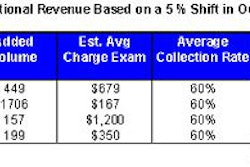NAPLES, FL - Whether a radiology group is opening the doors of a brand-new facility or is already the dominant player in its area, a marketing plan is key to a successful imaging center. Without a plan, a practice will be in the unenviable position of reacting to market forces and playing catch up.
"A marketing plan is a strategic roadmap that defines the goals of a practice," said Patricia Kroken in her talk Sunday at a special session of the Radiology Business Management Association summit. Kroken is president of Albuquerque, NM-based Healthcare Resource Providers.
The first step in creating a viable marketing plan is knowing where a practice is, and where it wants to go in the future. This step requires the practice to outline its goals, and then establish a system of periodic measurements to ensure that the goals are realized. An inventory of current resources, such as personnel dedicated to marketing and the creation of marketing materials, will provide a picture of the tools needed to establish a marketing presence.
The cartography of a marketing plan
Surveying the competitive landscape will reveal how a practice should map out its marketing. Issues to assess are the strengths and weaknesses of other radiology groups or imaging centers, including the modalities they offer, the locations in which they operate, the hours of their facilities, and the services they provide, Kroken said.
In addition, the overall status of the area’s radiology market -- such as scheduling backlogs, accreditation, payor contracts, and the marketing efforts of competitors -- should also be examined. The basic goals of any firm should be to gain new business, support the expansion of services, and protect its market share, she added.
The customers of radiology -- referring physicians, patients, hospitals, and health plans -- each have their own set of needs, and a successful marketing plan will adjust its course to meet those expectations.
"A tightly focused message about the quality of your group should be the paramount item that your marketing message conveys to all its customers. And this message needs to be portrayed in a way that each of the firm’s customers can perceive quality." Kroken said.
Charting the customer
For referring physicians, this message translates into prompt, hassle-free appointment scheduling, courteous behavior on the part of staff, physician-to-physician access, and prompt and dependable radiology reports. Achieving these results requires a facility to reach out to its physician customers and assess their perceptions of the firm.
Kroken recommended hand-delivered surveys to physician clients that are quick and easy to fill out. She advocated a checkbox format to ask physicians where they send their imaging business; what factors enter into their decision to use a particular center; how one facility compares with another; and what changes they would like to see at your facility.
"Before you even get this information, a group must be committed to making the changes its clients request. And once these changes are made, it’s equally important to get this information back to the requesting client," Kroken said.
To the referring physician’s appointment staff, a radiology group can distribute a list of its services and how they can be accessed. For the referring physician, a practice can publish a short newsletter highlighting case studies and radiological applications.
Other marketing efforts include patient brochures that offer information on imaging exams, pre-exam prep, and what to expect at the imaging center. This can be accomplished via a traditional brochure sent to a patient when the appointment is made, or by directing a patient to a group’s Web site.
Regardless of the media used to deliver the practice’s commitment-to-quality message, patient convenience should always be emphasized.
This means providing each patient with a detailed map to the center in which they’re scheduled to have their procedure, the hours of operation of the center, and the estimated length of time needed to complete the procedure. It is also helpful to provide information about the range of insurance plans and billing -- including secondary billing -- that the center accepts, as well as payment options such as credit cards.
The message is the medium
Radiology groups can also benefit by marketing to hospitals they serve. Kroken observed that every turnover in a key administrative position at a hospital is an opportunity for a practice to create a new customer. In addition, semi-annual presentations about new services, capabilities, and new radiologists and their specialties keep the practice present in the minds of administrators.
"A health plan is often the forgotten customer of radiology," Kroken said. Marketing to this entity should have an educational focus, she noted. A radiologist from the group could schedule a presentation for the medical directors of a health plan about modalities that replace more invasive or traumatic options. The radiologist may also want to discuss new imaging options and the indications for ordering these exams.
Years to develop and minutes to lose
"Marketing isn’t something that is done solely by a representative of the group. It’s everybody in the practice’s job -- the radiologist, the technologist, the front desk, and billing and collections -- to support the goals of the marketing plan," Kroken noted.
As such, she advocated communicating the plans and context of a marketing campaign to internal staff before it goes into operation. This serves a two-fold purpose of garnering feedback from those most affected by the forthcoming strategy, and making them aware of their role and responsibility in ensuring the plan’s success.
It’s imperative that a practice deliver more than "marketing speak," Kroken cautioned. A firm has to have the operational infrastructure in place before a marketing plan can be implemented.
Front-line employees need to be trained, with internal communication processes in place, before a plan is enacted. Most important, the group must commit to change and provide feedback to the customers that their requests have resulted in action.
"As the old adage goes, it can take years to develop a business relationship and minutes to destroy one through poor service," Kroken said.
By Jonathan S. BatchelorAuntMinnie.com staff writer
June 5, 2002
Related Reading
Site development is key to marketing radiology on the Web, August 9, 2001
e-Radiology enhances marketing opportunities, July 24, 2001
Strategic marketing brings in referring physicians, June 27, 2001
A Tale of Two Practices: Marketing is not going to the supermarket, May 12, 2000
A Tale of Two Practices, Part III: All in the Family, April 10, 2000
A Tale of Two Practices: When family ties are binding, March 17, 2000
Copyright © 2002 AuntMinnie.com



















